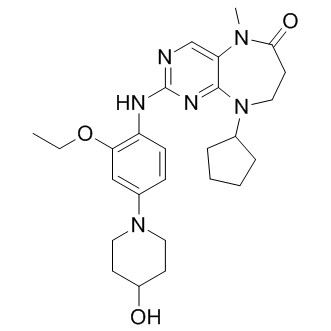| Description: |
Mps1-IN-2 is a potent, selective and ATP-competitive dual Mps1/Plk1 inhibitor, with an IC50 and a Kd of 145 nM and 12 nM for Mps1 and a Kd of 61 nM for Plk1. |
| Target: |
Mps1:12 nM (Kd)
GAK:140 nM (Kd)
PLK1:61 nM (Kd)
PLK3:1600 nM (Kd)
PLK4:3100 nM (Kd)
STK33:5000 nM (Kd) |
| In Vitro: |
Mps1-IN-2 is a potent, selective and ATP-competitive Mps1 kinase inhibitor, with an IC50 and a Kd of 145 nM and 12 nM. Mps1-IN-2 also shows high affinity for PLK1 and GAK with Kds of 61 and 140 nM, respectively, but shows little or no inhibition on other 352 member kinases. Mps1-IN-2 can induces bypass of a checkpoint-mediated mitotic arrest in U2OS cells[1]. |
| Kinase Assay: |
The kinase binding assay is used to assess compound binding to TTK by monitoring displacement of a fluorescently labeled, ATP site-directed kinase inhibitor (Kinase Tracer 236) from the kinase active site. Each 15 μL assay contains 5 nM TTK, variable amounts of test compound (Mps1-IN-2), 30 nM Kinase Tracer 236, 2 nM Eu-anti-GST Antibody, and 1% DMSO (residual from compound dilution) in Kinase Buffer A (50 mM HEPES pH 7.5, 10 mM MgCl2, 1 mM EGTA, 0.01% Brij-35). Binding assays are initiated by addition of 5 μL of test compound (from 2-fold dilution series) to 5 μL of a kinase/antibody mixture, followed by addition of 5 μL of antibody. Assay plates are read using using standard Eu-based TR-FRET settings with excitation at 340 nm and emission monitored at 615 nm (donor) and 665 nm (acceptor). Emission intensities are measured over a 200 µs window following a 100 µs post-excitation delay[1]. |
| References: |
[1]. Kwiatkowski N, et al. Small-molecule kinase inhibitors provide insight into Mps1 cell cycle function. Nat Chem Biol. 2010 May;6(5):359-68. |






















